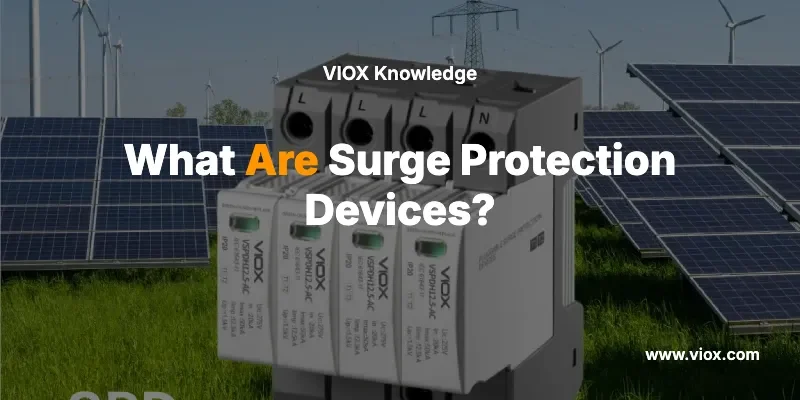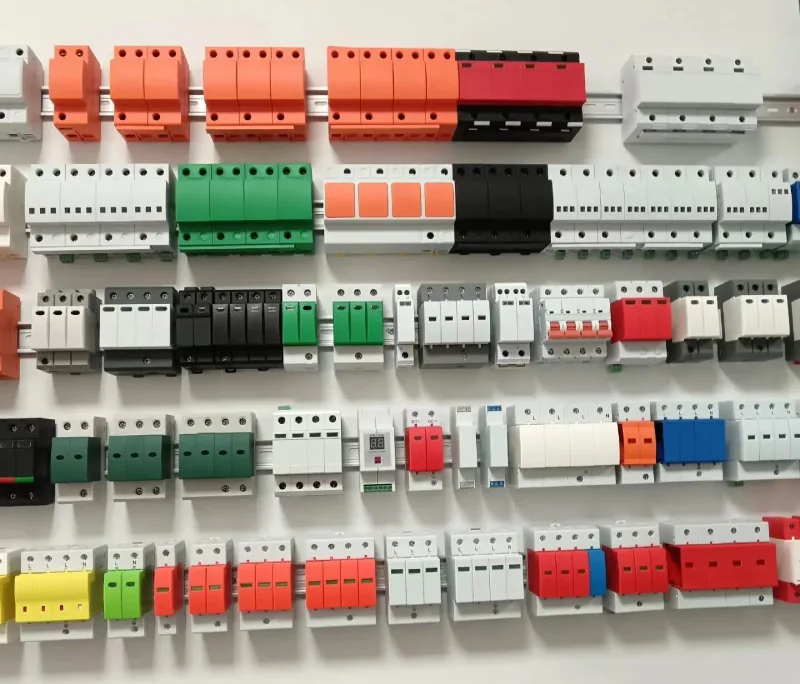อุปกรณ์ป้องกันไฟกระชาก (SPDs) ป้องกันความเสียหายทางไฟฟ้าโดยการเปลี่ยนทิศทางแรงดันไฟฟ้าส่วนเกินออกจากอุปกรณ์อิเล็กทรอนิกส์ที่ไวต่อความเสียหาย แต่ก็ทำให้เกิดจุดที่อาจเกิดความล้มเหลวและข้อกำหนดในการบำรุงรักษาอย่างต่อเนื่อง. แม้ว่า SPDs จะสามารถประหยัดค่าใช้จ่ายในการเปลี่ยนอุปกรณ์ได้หลายพัน แต่การทำความเข้าใจข้อจำกัดของอุปกรณ์เหล่านี้เป็นสิ่งสำคัญสำหรับการตัดสินใจด้านความปลอดภัยทางไฟฟ้าอย่างรอบคอบ.
อุปกรณ์ป้องกันไฟกระชากคืออะไร?
อุปกรณ์ป้องกันไฟกระชากเป็นส่วนประกอบทางไฟฟ้าที่ตรวจจับแรงดันไฟฟ้าที่สูงขึ้นอย่างรวดเร็วและเปลี่ยนทิศทางพลังงานไฟฟ้าส่วนเกินลงดิน เพื่อปกป้องอุปกรณ์ที่เชื่อมต่อจากความเสียหาย. SPDs ทำงานโดยการตรวจสอบระดับแรงดันไฟฟ้าขาเข้าและเปิดใช้งานภายในไมโครวินาทีเมื่อแรงดันไฟฟ้าเกินเกณฑ์ที่ปลอดภัย โดยทั่วไปคือ 150V สำหรับวงจร 120V.
การจำแนกประเภท SPD ที่สำคัญ:
- ประเภท 1 SPDs: การป้องกันทางเข้าบริการ (ด้านสาธารณูปโภค)
- ประเภทที่ 2 SPDs: การป้องกันแผงจ่ายไฟ (ที่อยู่อาศัยทั่วไปส่วนใหญ่)
- ประเภท 3 SPDs: การป้องกัน ณ จุดใช้งาน (เต้ารับแต่ละตัว)
อุปกรณ์ป้องกันไฟกระชาก: การเปรียบเทียบข้อดีและข้อเสียโดยสมบูรณ์
| นายได้เปรียบอะไรบ้าง | Disadvantages |
|---|---|
| การป้องกันอุปกรณ์: ป้องกันความเสียหายต่ออุปกรณ์อิเล็กทรอนิกส์ที่มีมูลค่าหลายพันดอลลาร์ | อายุการใช้งานที่จำกัด: ส่วนประกอบเสื่อมสภาพเมื่อเกิดเหตุการณ์ไฟกระชากแต่ละครั้ง |
| การปฏิบัติตามข้อกำหนดด้านประกันภัย: บริษัทประกันภัยหลายแห่งกำหนดให้ต้องมีเพื่อการคุ้มครองการเรียกร้องค่าสินไหมทดแทน | ไม่มีการรับประกัน 100%: ไม่สามารถป้องกันไฟกระชากได้ทุกประเภท |
| รทำตามข้อตกล: กำหนดโดย NEC 2020+ สำหรับการติดตั้งจำนวนมาก | ต้องมีการบำรุงรักษา: ต้องมีการทดสอบและเปลี่ยนเป็นประจำ |
| การป้องกันหลายระดับ: สามารถติดตั้งได้ที่ทางเข้าบริการ แผง และระดับเต้ารับ | ต้นทุนการติดตั้ง: ค่าติดตั้งโดยผู้เชี่ยวชาญอยู่ในช่วง 200-800 ดอลลาร์ขึ้นไป |
| เวลาตอบสนองที่รวดเร็ว: เปิดใช้งานภายในหน่วยนาโนวินาทีของการตรวจจับแรงดันไฟฟ้าที่สูงขึ้นอย่างรวดเร็ว | ความปลอดภัยที่ผิดพลาด: อาจล้มเหลวโดยไม่มีข้อบ่งชี้ที่มองเห็นได้ |
| ความคุ้มครองการรับประกัน: ผู้ผลิตหลายรายเสนอการรับประกันอุปกรณ์ที่เชื่อมต่อ | การพึ่งพาการต่อลงดิน: ต้องมีการต่อลงดินที่เหมาะสมเพื่อให้ทำงานได้อย่างมีประสิทธิภาพ |
| การลดเสียงรบกวน: กรองสัญญาณรบกวนทางไฟฟ้า ปรับปรุงประสิทธิภาพของอุปกรณ์ | ความไวต่ออุณหภูมิ: อุณหภูมิที่สูงเกินไปส่งผลต่อประสิทธิภาพ |
เคล็ดลับจากผู้เชี่ยวชาญ
⚡ คำเตือนด้านความปลอดภัย: ติดตั้ง SPDs โดยช่างไฟฟ้าที่มีใบอนุญาตเสมอ การติดตั้งที่ไม่เหมาะสมอาจก่อให้เกิดอันตรายจากไฟไหม้และทำให้การคุ้มครองประกันภัยเป็นโมฆะ.
💡ผู้เชี่ยวชาญด้านทิป: ติดตั้งระบบป้องกันสามระดับ: Type 1 ที่ทางเข้าบริการ, Type 2 ที่แผงไฟฟ้า และ Type 3 ที่อุปกรณ์ที่ไวต่อความเสียหายเพื่อการป้องกันสูงสุด.
ข้อดีโดยละเอียดของอุปกรณ์ป้องกันไฟกระชาก
มูลค่าการป้องกันอุปกรณ์
SPDs ป้องกันแรงดันไฟฟ้าที่สูงขึ้นอย่างรวดเร็วซึ่งสามารถทำลายอุปกรณ์อิเล็กทรอนิกส์ได้ทันที ฟ้าผ่าเพียงครั้งเดียวสามารถสร้างแรงดันไฟฟ้าได้มากกว่า 100,000 โวลต์ ในขณะที่อุปกรณ์อิเล็กทรอนิกส์สำหรับผู้บริโภคส่วนใหญ่ออกแบบมาสำหรับการทำงานที่ 120V. ค่าใช้จ่ายเฉลี่ยในการเปลี่ยนอุปกรณ์อิเล็กทรอนิกส์ที่ถูกทำลายมีตั้งแต่ 3,000-15,000 ดอลลาร์ต่อครัวเรือน, ทำให้การลงทุนใน SPD คุ้มค่าอย่างยิ่ง.
การประกันภัยและการปฏิบัติตามข้อกำหนด
ประมวลกฎหมายไฟฟ้าแห่งชาติ (NEC) 2020 Article 230.67 กำหนดให้มีการป้องกันไฟกระชากสำหรับบริการที่อยู่อาศัยในเขตอำนาจศาลหลายแห่ง บริษัทประกันภัยกำหนดให้ต้องมี SPDs มากขึ้นสำหรับการคุ้มครองการเรียกร้องค่าสินไหมทดแทน โดยเฉพาะอย่างยิ่งในพื้นที่ที่มีแนวโน้มที่จะเกิดฟ้าผ่า.
กลยุทธ์การป้องกันหลายระดับ
การติดตั้งโดยผู้เชี่ยวชาญใช้การป้องกันที่ประสานงานกัน:
- SPD ทางเข้าบริการ จัดการไฟกระชากขนาดใหญ่จากสาธารณูปโภค
- แผง SPDs ป้องกันวงจรการกระจาย
- SPD ณ จุดใช้งาน ให้การป้องกันขั้นสุดท้ายสำหรับอุปกรณ์ที่ไวต่อความเสียหาย
ประสิทธิภาพเวลาตอบสนอง
SPDs คุณภาพตอบสนองภายใน 1-5 นาโนวินาที, เร็วกว่าความเสียหายของอุปกรณ์ที่สามารถเกิดขึ้นได้ การตอบสนองที่รวดเร็วนี้มีความสำคัญเนื่องจากแรงดันไฟฟ้าที่สูงขึ้นอย่างรวดเร็วสามารถทำลายส่วนประกอบเซมิคอนดักเตอร์ได้ในไมโครวินาที.
ข้อเสียและข้อจำกัดที่สำคัญ
อายุการใช้งานที่จำกัดและการเสื่อมสภาพ
SPDs เสียสละตัวเองเพื่อปกป้องอุปกรณ์อื่นๆ. เหตุการณ์ไฟกระชากแต่ละครั้งจะทำให้ส่วนประกอบภายในเสื่อมสภาพ ซึ่งในที่สุดจะต้องเปลี่ยนใหม่ SPDs ที่อยู่อาศัยส่วนใหญ่ต้องเปลี่ยนทุกๆ 5-10 ปี เร็วกว่าในสภาพแวดล้อมที่มีไฟกระชากสูง.
⚠️ การแจ้งเตือนด้านความปลอดภัย: SPDs ที่ล้มเหลวอาจไม่แสดงข้อบ่งชี้ถึงความล้มเหลวด้วยสายตา การทดสอบเป็นประจำด้วยมัลติมิเตอร์หรือไฟแสดงสถานะเป็นสิ่งจำเป็น.
ไม่มีการรับประกันการป้องกันอย่างสมบูรณ์
SPDs ไม่สามารถป้องกันไฟกระชากได้ทุกประเภท:
- ฟ้าผ่าโดยตรง อาจครอบงำการป้องกัน
- ไฟกระชากจากการสับสวิตช์ จากมอเตอร์ขนาดใหญ่อาจเกินความจุ
- แรงดันไฟฟ้าเกินอย่างต่อเนื่อง ต้องการวิธีการป้องกันที่แตกต่างกัน
ค่าใช้จ่ายในการติดตั้งและบำรุงรักษา
ค่าใช้จ่ายในการติดตั้ง SPD โดยผู้เชี่ยวชาญ:
- SPDs แผงควบคุมทั้งบ้าน: ติดตั้ง $300-$800
- SPD ทางเข้าบริการ: ติดตั้ง $500-$1,200
- ค่าใช้จ่ายในการตรวจสอบประจำปี: $75-$150
โปรแกรมและใช้คดี
การใช้งานสำหรับที่พักอาศัย
- โฮมเธียเตอร์และระบบความบันเทิง
- คอมพิวเตอร์และอุปกรณ์เครือข่าย
- ระบบ HVAC และเครื่องใช้ไฟฟ้า
- ระบบอัตโนมัติบ้านอัจฉริยะ
การใช้งานเชิงพาณิชย์
- ศูนย์ข้อมูลและห้องเซิร์ฟเวอร์
- อุปกรณ์การผลิต
- การป้องกันอุปกรณ์ทางการแพทย์
- โครงสร้างพื้นฐานด้านโทรคมนาคม
สภาพแวดล้อมที่มีความเสี่ยงสูงที่ต้องใช้ SPDs
- พื้นที่ที่มีฟ้าผ่าบ่อยครั้ง
- สถานที่ใกล้เคียงโรงงานอุตสาหกรรม
- อาคารที่มีสายไฟฟ้าเหนือศีรษะ
- สิ่งอำนวยความสะดวกที่มีอุปกรณ์อิเล็กทรอนิกส์ที่ละเอียดอ่อน
เกณฑ์และข้อกำหนดในการเลือก SPD
| Specification | มาตรฐานที่อยู่อาศัย | มาตรฐานเชิงพาณิชย์ | ระบบวิกฤต |
|---|---|---|---|
| Voltage ระดับความชื่นชอบ | 150V (ระบบ 120V) | 320V (ระบบ 277V) | ออกแบบตามความต้องการ |
| ปัจจุบันระดับความชื่นชอบ | ขั้นต่ำ 20kA | ขั้นต่ำ 40kA | 100kA+ |
| การตอบสนองเวลา | <5 นาโนวินาที | <1 นาโนวินาที | <1 นาโนวินาที |
| พิกัด MCOV | 150V ต่อเนื่อง | 320V ต่อเนื่อง | เฉพาะระบบ |
| รายการ UL | UL 1449 ประเภท 2 | UL 1449 ประเภท 1/2 | UL 1449 + มาตรฐาน IEEE |
วิธีเลือก SPD ที่เหมาะสม
ขั้นตอนที่ 1: กำหนดระดับการป้องกันที่ต้องการ
- ประเมินมูลค่าอุปกรณ์และค่าใช้จ่ายในการเปลี่ยน
- ระบุปัจจัยเสี่ยงไฟกระชากในพื้นที่ (ความถี่ฟ้าผ่า, คุณภาพไฟฟ้า)
- ตรวจสอบข้อกำหนดด้านการประกันภัยและรหัส
ขั้นตอนที่ 2: คำนวณข้อกำหนดของระบบไฟฟ้า
- วัดกระแสไฟฟ้าเข้าบริการ
- ระบุการกำหนดค่าแผงควบคุม (เฟสเดียว/สามเฟส)
- ตรวจสอบความเพียงพอของระบบสายดิน
ขั้นตอนที่ 3: เลือกประเภท SPD ที่เหมาะสม
- ตัวเลือกงบประมาณ: SPDs ประเภท 2 ที่ติดตั้งบนแผงควบคุม ($150-$300)
- การป้องกันมาตรฐาน: การรวมกันของทั้งบ้าน + จุดใช้งาน ($400-$800)
- การป้องกันระดับพรีเมียม: ระบบประสานงานสามระดับ ($800-$1,500)
💡 เคล็ดลับจากผู้เชี่ยวชาญ: ควรให้คะแนน SPD มากกว่า 25-50% เสมอ เพื่อชดเชยการเสื่อมสภาพเมื่อเวลาผ่านไป และให้แน่ใจว่ามีขอบเขตการป้องกันที่เพียงพอ.
กระบวนการและข้อกำหนดในการติดตั้ง
การประเมินก่อนการติดตั้ง
- การประเมินระบบไฟฟ้า โดยช่างไฟฟ้าที่มีใบอนุญาต
- การตรวจสอบระบบสายดิน (ความต้านทาน <25 โอห์ม)
- ความพร้อมใช้งานของพื้นที่แผงควบคุม การยืนยัน
- การปฏิบัติตามรหัสท้องถิ่น รีวิว
ขั้นตอนการติดตั้งอย่างมืออาชีพ
- ปิดระบบไฟฟ้า และขั้นตอนการล็อกเอาต์เพื่อความปลอดภัย
- การติดตั้งขายึด ในแผงไฟฟ้า
- การเชื่อมต่อสายไฟ ตามข้อกำหนดของผู้ผลิต
- การติดตั้งตัวนำลงดิน (สำคัญต่อการทำงาน)
- การทดสอบระบบ และเอกสาร
⚠️ คำเตือนด้านความปลอดภัยที่สำคัญ: อย่าพยายามติดตั้ง SPD ด้วยตัวเอง งานแผงไฟฟ้าต้องใช้ความเชี่ยวชาญระดับมืออาชีพ และอาจละเมิดกฎหมายท้องถิ่นและนโยบายประกันภัย.
การบำรุงรักษาและการแก้ไขปัญหา
ตารางการบำรุงรักษาตามปกติ
- จำเดือน: การตรวจสอบด้วยสายตาของไฟแสดงสถานะ
- Quarterly: การตรวจสอบการวัดแรงดันไฟฟ้า
- ทุกปีเดินตรง:การตรวจสอบระบบไฟฟ้าอย่างมืออาชีพ
- หลังพายุใหญ่: การทดสอบการทำงานของ SPD อย่างสมบูรณ์
ปัญหาและแนวทางแก้ไขทั่วไปของ SPD
| ปัญหา | อาการ | แนวทางแก้ไขอย่างมืออาชีพ |
|---|---|---|
| SPD ล้มเหลว | ไม่มีไฟแสดงสถานะ อุปกรณ์เสียหาย | เปลี่ยน SPD ใหม่ทั้งหมด |
| การสะดุดสิ่งรบกวน | เบรกเกอร์สะดุดบ่อยครั้ง | ตรวจสอบ SPD ที่มีขนาดใหญ่เกินไป, ความผิดพลาดของกราวด์ |
| การป้องกันบางส่วน | อุปกรณ์บางส่วนได้รับผลกระทบ | ตรวจสอบขนาดสายไฟและการเชื่อมต่อที่เหมาะสม |
| ปัญหาความผิดพลาดของกราวด์ | SPD ไม่ทำงาน | การอัพเกรดระบบกราวด์อย่างมืออาชีพ |
เมื่อใดควรโทรหาผู้เชี่ยวชาญ
ต้องการความช่วยเหลือจากมืออาชีพทันที:
- การปรับเปลี่ยนแผงไฟฟ้าใดๆ
- การติดตั้ง SPD ทั่วทั้งบ้าน
- หลังฟ้าผ่าหรือไฟกระชากครั้งใหญ่
- เมื่อไฟแสดงสถานะ SPD แสดงความล้มเหลว
- สำหรับเอกสารประกอบการเรียกร้องค่าสินไหมทดแทน
ช่างไฟฟ้าที่ได้รับการรับรองต้อง:
- ตรวจสอบระบบกราวด์ที่เหมาะสม
- ตรวจสอบให้แน่ใจว่าการติดตั้งเป็นไปตามข้อกำหนด
- จัดทำเอกสารที่เหมาะสมสำหรับการประกันภัย
- คำนวณพิกัด SPD ที่เหมาะสมสำหรับระบบของคุณ
คำถามที่พบบ่อยเกี่ยวกับอุปกรณ์ป้องกันไฟกระชาก
อุปกรณ์ป้องกันไฟกระชากทำงานได้จริงสำหรับการป้องกันฟ้าผ่าหรือไม่?
SPDs ให้การป้องกันที่สำคัญ แต่ไม่สามารถรับประกันการป้องกัน 100% จากฟ้าผ่าโดยตรง. พวกเขาเก่งในการป้องกันฟ้าผ่าทางอ้อมและไฟกระชากของระบบสาธารณูปโภค ซึ่งคิดเป็น 80% ของเหตุการณ์ความเสียหายทางไฟฟ้า.
อุปกรณ์ป้องกันไฟกระชากมีอายุการใช้งานนานเท่าใด?
SPDs ทั่วทั้งบ้านโดยทั่วไปมีอายุการใช้งาน 5-10 ปี, ขึ้นอยู่กับความถี่ของไฟกระชากและสภาพไฟฟ้าในท้องถิ่น อุปกรณ์ป้องกันไฟกระชาก ณ จุดใช้งานอาจต้องเปลี่ยนทุกๆ 2-3 ปีในสภาพแวดล้อมที่มีไฟกระชากสูง.
ฉันสามารถติดตั้งอุปกรณ์ป้องกันไฟกระชากด้วยตัวเองได้หรือไม่?
SPDs ที่ติดตั้งบนแผงต้องได้รับการติดตั้งอย่างมืออาชีพโดยช่างไฟฟ้าที่ได้รับใบอนุญาต. การติดตั้ง DIY ละเมิดรหัสไฟฟ้าในท้องถิ่นส่วนใหญ่ และอาจสร้างอันตรายด้านความปลอดภัยร้ายแรงและปัญหาความคุ้มครองประกันภัย.
อะไรคือความแตกต่างระหว่างอุปกรณ์ป้องกันไฟกระชากและอุปกรณ์ป้องกันไฟกระชาก?
อุปกรณ์ป้องกันไฟกระชาก (SPDs) เป็นการติดตั้งแผงไฟฟ้าถาวร, ในขณะที่อุปกรณ์ป้องกันไฟกระชากโดยทั่วไปเป็นอุปกรณ์ปลั๊กอินสำหรับเต้ารับแต่ละช่อง SPDs ให้การป้องกันทั่วทั้งบ้านด้วยเวลาตอบสนองที่เร็วกว่า.
ฉันต้องการการป้องกันไฟกระชากหรือไม่หากฉันมีเต้ารับ GFCI
เต้ารับ GFCI ป้องกันความผิดพลาดของกราวด์ ไม่ใช่ไฟกระชาก. SPDs และการป้องกัน GFCI ทำหน้าที่ด้านความปลอดภัยที่แตกต่างกัน และทั้งสองอย่างได้รับการแนะนำเพื่อการป้องกันทางไฟฟ้าที่ครอบคลุม.
ค่าใช้จ่ายในการป้องกันไฟกระชากทั่วทั้งบ้านมีราคาเท่าไหร่?
การติดตั้ง SPDs ทั่วทั้งบ้านอย่างมืออาชีพมีราคาตั้งแต่ 300-800 ดอลลาร์, ขึ้นอยู่กับการกำหนดค่าแผงและอัตราค่าแรงในท้องถิ่น การลงทุนนี้โดยทั่วไปจะจ่ายคืนเองโดยการป้องกันการสูญเสียอุปกรณ์หลักเพียงครั้งเดียว.
อุปกรณ์ป้องกันไฟกระชากจะช่วยลดค่าไฟฟ้าของฉันได้หรือไม่?
SPDs อาจลดสัญญาณรบกวนทางไฟฟ้าเล็กน้อย, ซึ่งอาจปรับปรุงประสิทธิภาพของเครื่องใช้ไฟฟ้า แต่ไม่ใช่เครื่องมือประหยัดพลังงานเป็นหลัก คุณค่าของมันอยู่ที่การปกป้องอุปกรณ์มากกว่าการลดค่าไฟฟ้า.
อุปกรณ์ป้องกันไฟกระชากสามารถล้มเหลวได้โดยไม่มีการเตือนหรือไม่?
ใช่ SPDs สามารถล้มเหลวอย่างเงียบๆ โดยไม่มีตัวบ่งชี้ที่มองเห็นได้. นี่คือเหตุผลที่การทดสอบและการตรวจสอบไฟแสดงสถานะอย่างมืออาชีพเป็นประจำมีความจำเป็นอย่างยิ่งสำหรับการรักษาการป้องกัน.
การตัดสินใจที่ถูกต้อง: การวิเคราะห์การลงทุน SPD
กรอบการวิเคราะห์ต้นทุนและผลประโยชน์
การลงทุนด้านการป้องกัน:
- ต้นทุนเริ่มต้น: 300-800 ดอลลาร์ (การติดตั้งอย่างมืออาชีพ)
- การซ่อมบำรุง: $50-$100 ต่อปี
- การทดแทน: ทุกๆ 5-10 ปี
การประหยัดที่อาจเกิดขึ้น:
- ค่าเฉลี่ยการเปลี่ยนอุปกรณ์อิเล็กทรอนิกส์: $3,000-$15,000
- การเปลี่ยนระบบ HVAC: $5,000-$15,000
- การประหยัดค่าใช้จ่ายส่วนแรกของประกัน: $500-$2,500
- การป้องกันการหยุดทำงานของธุรกิจ: แตกต่างกันอย่างมาก
ปัจจัยการประเมินความเสี่ยง
สถานการณ์ที่มีความเสี่ยงสูงที่ต้องใช้อุปกรณ์ป้องกันไฟกระชาก (SPD):
- พายุฝนฟ้าคะนองบ่อยครั้ง (>30 วันต่อปี)
- พื้นที่ชนบทที่มีสายไฟฟ้าเหนือศีรษะ
- บ้านที่มีอุปกรณ์อิเล็กทรอนิกส์และระบบอัจฉริยะจำนวนมาก
- อาคารที่มีระบบสายดินไม่เพียงพอ
- พื้นที่ที่มีคุณภาพไฟฟ้าจากสาธารณูปโภคไม่ดี
บทสรุปและข้อเสนอแนะจากผู้เชี่ยวชาญ
อุปกรณ์ป้องกันไฟกระชากมีประโยชน์อย่างมากในการปกป้องอุปกรณ์และการปฏิบัติตามข้อกำหนด แต่ต้องมีการเลือกที่เหมาะสม การติดตั้งโดยผู้เชี่ยวชาญ และการบำรุงรักษาอย่างต่อเนื่องเพื่อให้มีประสิทธิภาพ. การลงทุนใน SPD ที่มีคุณภาพโดยทั่วไปจะคุ้มค่าด้วยตัวมันเองโดยการป้องกันการสูญเสียอุปกรณ์หลักเพียงครั้งเดียว.
คำแนะนำจากผู้เชี่ยวชาญ:
- ติดตั้งระบบป้องกันสามระดับเพื่อให้ครอบคลุมอย่างทั่วถึง
- ใช้อุปกรณ์ที่ได้รับการรับรองจาก UL เท่านั้นที่ตรงตามมาตรฐาน NEC ปัจจุบัน
- จ้างช่างไฟฟ้าที่มีใบอนุญาตสำหรับการติดตั้งระดับแผงทั้งหมด
- ดำเนินการตามตารางการบำรุงรักษาเป็นประจำเพื่อให้มั่นใจถึงการป้องกันอย่างต่อเนื่อง
- จัดทำเอกสารการติดตั้งอย่างถูกต้องเพื่อการปฏิบัติตามข้อกำหนดด้านประกันภัย
บรรทัดล่าง: SPD เป็นการลงทุนด้านความปลอดภัยที่จำเป็นสำหรับบ้านและธุรกิจสมัยใหม่ แต่ความสำเร็จขึ้นอยู่กับการออกแบบระบบที่เหมาะสม การติดตั้งโดยผู้เชี่ยวชาญ และความมุ่งมั่นในการบำรุงรักษาอย่างต่อเนื่อง.
สำหรับคำแนะนำ SPD เฉพาะและการติดตั้งโดยผู้เชี่ยวชาญในพื้นที่ของคุณ โปรดปรึกษาผู้รับเหมาไฟฟ้าที่มีใบอนุญาตซึ่งคุ้นเคยกับรหัสท้องถิ่นและข้อกำหนดในการป้องกันไฟกระชาก ให้ความสำคัญกับความปลอดภัยและการปฏิบัติตามข้อกำหนดมากกว่าการประหยัดค่าใช้จ่ายเสมอเมื่อปกป้องระบบไฟฟ้าของคุณ.
เกี่ยวข้องกัน
อุปกรณ์ป้องกันไฟกระชาก (SPD) คืออะไร
วิธีเลือก SPD ที่เหมาะสมสำหรับระบบพลังงานแสงอาทิตย์ของคุณ
อุปกรณ์ป้องกันไฟกระชาก (SPD) แตกต่างจากวิธีป้องกันไฟกระชากไฟฟ้าแบบอื่นอย่างไร




